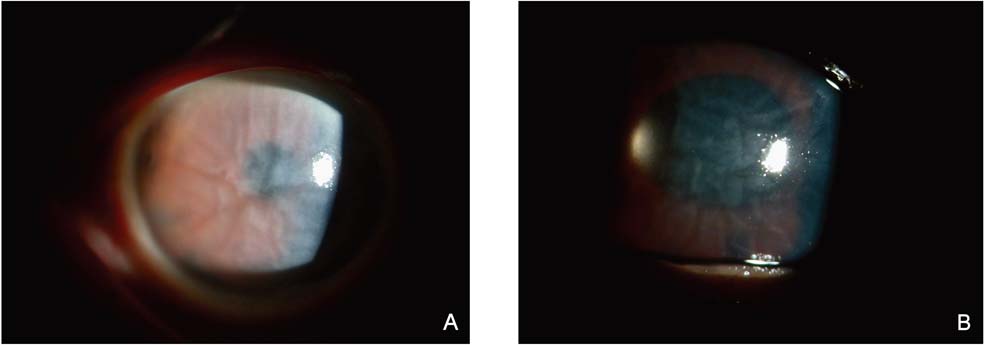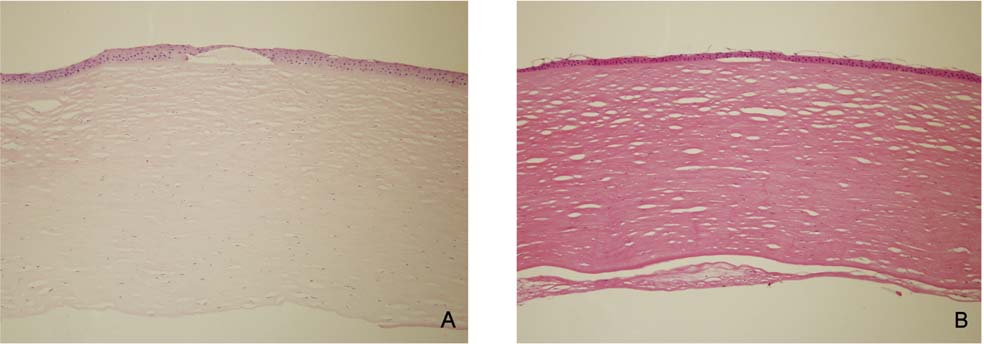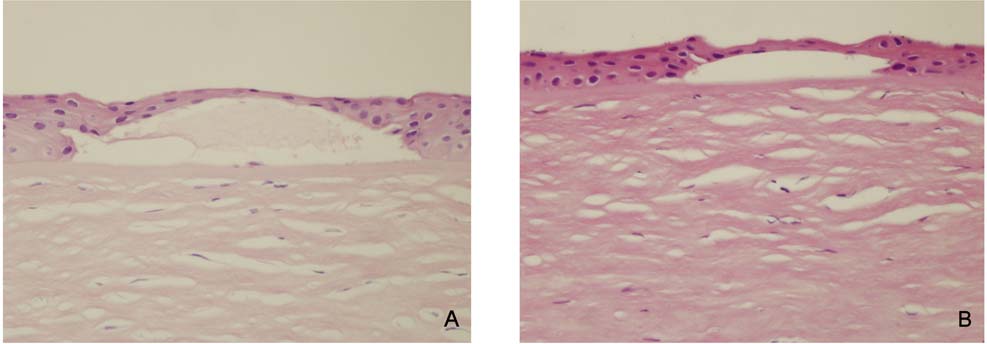Korean J Ophthalmol.
2008 Dec;22(4):220-227. 10.3341/kjo.2008.22.4.220.
Development of Toxic Anterior Segment Syndrome Immediately after Uneventful Phaco Surgery
- Affiliations
-
- 1Department of Ophthalmology, Seoul National University College of Medicine, Seoul, Korea.
- 2Department of Ophthalmology, Gachon University Gil Medical Center, Incheon, Korea. khshyn@gilhospital.com
- KMID: 1084208
- DOI: http://doi.org/10.3341/kjo.2008.22.4.220
Abstract
- PURPOSE: We report on 15 cases of suspected toxic anterior segment syndrome after uneventful phaco surgery. METHODS: We retrospectively reviewed the charts of patients who had developed toxic anterior segment syndrome (TASS) after uneventful phacoemulsification for senile cataracts between April and December of 2005. Clinical features and all possible causes were investigated including irrigating solutions or drugs, surgical instruments or intraocular lenses, sterilization techniques for instruments, or any other accompanying disease. RESULTS: The patients consisted of 2 males and 13 females with an average age of 64.7+/-10.9 years. Five different surgeons had performed their phaco surgeries. No abnormal preoperative or operative findings were reported. Nevertheless, all 15 patients developed a moderate degree of corneal edema. Ordinary treatments were not helpful. We suspect that lack of sterilization resulted in the development of the syndrome, because after ethylene oxide gas sterilization was replaced with autoclaving, no such incidents have occurred. CONCLUSIONS: Toxic anterior segment syndrome requires special attention and thorough management, including sterilization of reused surgical instruments.
MeSH Terms
-
Aged
Aged, 80 and over
Anterior Eye Segment/*pathology
Corneal Edema/*etiology/pathology/surgery
Endophthalmitis/*etiology/pathology/surgery
Endotoxins/adverse effects
Female
Humans
Keratoplasty, Penetrating
*Lens Implantation, Intraocular
Male
Middle Aged
*Phacoemulsification
*Postoperative Complications
Retrospective Studies
Syndrome
Figure
Reference
-
1. Mamalis N, Edelhauser HF, Dawson DG, et al. Toxic anterior segment syndrome. J Cataract Refract Surg. 2006. 32:324–333.2. Geffen J, Webster R. Krachmer JH, Mannis MJ, Holland EJ, editors. Corneal edema. Cornea: Fundamentals of Cornea and External Disease. 1997. St. Louis: Mosby-Yearbook;409–415.3. Meltzer DW. Sterile hypopyon following intraocular lens surgery. Arch Ophthalmol. 1980. 98:100–104.4. Richburg FA, Reidy JJ, Apple DJ, Olson RJ. Sterile hyopoyon secondary to ultrasonic cleaning solution. J Cataract Refract Surg. 1986. 12:248–251.5. Nelson DB, Donnenfeld ED, Perry HD. Sterile endophthalmitis after sutureless cataract surgery. Ophthalmology. 1992. 99:1655–1657.6. Werner L, Sher JH, Taylor JR, et al. Toxic anterior segment syndrome and possible association with ointment in the anterior chamber following cataract surgery. J Cataract Refract Surg. 2006. 32:227–235.7. Monson MC, Mamalis N, Olson RJ. Toxic anterior segment inflammation following cataract surgery. J Cataract Refract Surg. 1992. 18:184–189.8. Steinert RF. Cataract Surgery: Technique, Complications, and Management. 2004. 2nd ed. Philadelphia: Saunders;507–513.9. Yoon KC, Lim DW, Yang KJ. Toxic corneal reaction induced by distilled water infused during cataract operation. J Korean Ophthalmic Soc. 2003. 44:1448–1451.10. Choe DU, Jeong IY, Seo SU, Song JG. A case of anterior chamber irrigation with distilled water during cataract operation. J Korean Ophthalmic Soc. 2004. 45:328–332.11. Holland SP, Morck DW, Lee TL. Update on toxic anterior segment syndrome. Curr Opin Ophthalmol. 2007. 18:4–8.12. Glasser DB, Schultz RO, Hyndiuk RA. The role of viscoelastics, cannulas, and irrigating solution additives in post-cataract surgery corneal edema: a brief review. Lens Eye Toxic Res. 1992. 9:351–359.13. Glasser DB. Chandler JW, Sugar J, Edelhauser HF, editors. Pathophysiology of corneal endothelia dysfunction. External Disease: Cornea, Conujunctiva, Sclear, Eyelids, Lacrimal System. 1994. St Louis, Mo: Mosby-Year Book Inc;8.1–8.19.14. Breedbaart AC, Nuyts R, Peis E, et al. Toxic endothelial cell destruction of the cornea after routine extracapsular cataract surgery. Arch Ophthalmol. 1990. 108:1121–1125.15. Phinney RB, Mondino BJ, Hofbauer JD, et al. Corneal edema related to accidental Hibiclens exposure. Am J Ophthalmol. 1988. 106:210–215.16. Mac Rae SM, Brown B, Edelhauser HF. The corneal toxicity of presurgical skin antiseptics. Am J Ophthalmol. 1984. 97:221–232.17. Edelhauser HF, Hyndiuk RA, Zeeb A, Schultz RO. Corneal edema and the intraocular use of epinephrine. Am J Ophthalmol. 1982. 93:327–333.18. Kadonosono K, Ito N, Yazama F, et al. Effects of intracameral anesthesia on the corneal endothelium. J Cataract Refract Surg. 1998. 24:1377–1381.19. Garcia-Ferrer FJ, Pepose JS, Murray PR, et al. Antimicrobial efficacy and corneal endothelial toxiciey of DexSol corneal storage medium supplemented with vancomycin. Ophthalmology. 1991. 98:863–869.20. Artola A, Alio JL, Bellot JS, Ruiz JM. Protective properties of viscoelastic substances (sodium hyaluronate and 2% hycroxymethylcellulose) againstexperimental free radical damage to cornea endothelium. Cornea. 1993. 12:109–114.21. Olson RJ. Air and the corneal endothelium: an in vivo specular microscopy study in cats. Arch Ophthalmol. 1980. 98:1283–1284.22. Edelhauser HF. The resiliency of the corneal endothelium to refractive and intraocular surgery. Cornea. 2000. 19:263–273.23. Britton B, Hervey R, Kasten K, et al. Intraocular irritation evaluation of benzalkonium chloride in rabbits. Ophthalmic Surg. 1976. 7:46–55.24. Pastor SA, Williams R, Hetherington J, et al. Corneal endothelial cell loss following trabeculectomy with mitomycin C. J Glaucoma. 1993. 2:112–113.25. Parikh C, Sippy BD, Martin DF, Edelhauser HF. Effects of enzymatic sterilization detergents on the corneal endothelium. Arch Ophthalmol. 2002. 120:165–172.26. Kreisler KR, Martin SS, Young CW, et al. Postoperative inflammation following cataract extraction caused by bacterial comtamination of the cleaning bath detergent. J Catarct Refract Surg. 1992. 18:106–110.27. Smith CA, Khoury JM, Shields SM, et al. Unexpected corneal endothelial cell decompensation after intraocular surgery with instruments sterilized by plasma gas. Ophthalmology. 2000. 107:1561–1566.28. Duffy RE, Brown SE, Caldwell KL, et al. An epidemic of corneal destruction caused by plasma gas sterilization. Arch Ophthalmol. 2000. 118:1167–1176.29. Worst JGF. A retrospective view on the sterilization of intraocular lenses and incidents of sterile hypopyon. J Am Intraocular Implant Soc. 1980. 6:10–12.
- Full Text Links
- Actions
-
Cited
- CITED
-
- Close
- Share
- Similar articles
-
- Four Cases of Toxic Anterior Syndrome after Cataract Surgery under Intracameral 0.5% Lidocaine Anesthesia
- Pseudophakic Pupillary Block after Toxic Anterior Segment Syndrome
- The Changes of Anterior Chamber Depth, Axial Length, Refractive Errors after Combined Vitrectomy
- A Toxic Anterior Segment Syndrome-like Ocular Inflammatory Reaction after COVID-19 Vaccination
- Toxic Anterior Segment Syndrome Following Cataract Surgery




